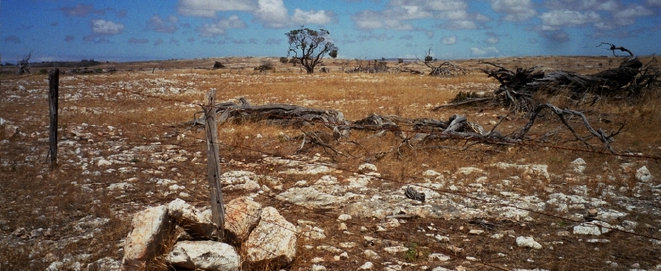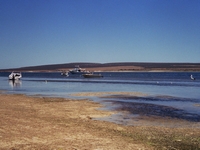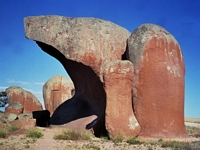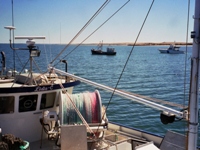Australia So Much to See


The cooler western coastline of the Eyre Peninsula in South Australia
Short version only - full version with pictures yet to come
The Western Eyre Peninsula
Leaving Ceduna, we headed south on the Flinders Highway, visiting Smoky Bay. In 1802, Captain Matthew
Flinders mapped the area from Fowlers Bay and because of "the number of smokes rising from the shores of this wide open space" named Smoky Bay. This small town is on a sheltered Bay, and is known for its oysters. Once a whaling station was nearby at Point
Collinson, and the Point Brown Conservation Park and Acraman Creek are on the same peninsula that forms the protective Smoky Bay.
We then went to Haslam and stayed overnight. This small fishing community has an honesty box camping area right
by the jetty. Showers and free electricity have been removed due to lack of honesty contributions, but there are toilets, barbecue
and potable water. This is away from the houses in the small town so an ideal overnight spot. It was extremely windy during
the night.
In the morning, a fisherman from a trailer home in a parking area further away from the beach kept coming to check
to water levels. When the tide was low enough, he towed the boat out through the shallows to launch it at the edge of the deeper
water, then took the tractor back to shore before running out through the shallows to catch the boat.
A little further
to the south, Perlubie Bay has a popular camp spot on a bay looking across to Eba Island.




We followed the coastline south to Streaky Bay. In 1802 Matthew Flinders named Streaky Bay. It is now known thought the
streaks which gave rise to the name are caused by the release of oils by certain species of seaweed in the bay. This bay is
well protected by a peninsula which includes some rugged cliffs. There are a number of scenic drives. We did these during
two visits to Streaky Bay.
The Cape Bauer Drive follows the edge of the rugged peninsula to the north west of Streaky Bay. This sea stack is a symmetrical small circular island, cut away from the limestone cliffs by the action of the sea.
The Westall
Way goes to the coast where the cliffs are taller. We were high above the ocean looking across to High Cliff in the setting
sun. Nearby, Smooth Pool remains glassy while the surf beats onto the rock barrier.
A little further south is the fishing
village of Sceale Bay. Here all manner of tow vehicles were parked at the boat launching ramp.
Don’t miss going
to Point Labatt; the only full time mainland sea lion breeding colony, but take binoculars as you can only watch them from the top
of the cliff. Cows and calves were basking on the beach, with the bulls having the occasional fight. Some sea lions went
fishing out in the channel where huge shoals of salmon were swimming through.
Cropped paddocks went to the water’s edge
along a long narrow strip of turquoise water – the head of Baird Bay. A small settlement is near the mouth of this long inlet
and pelicans watched the moored boats.
Murphy’s Haystacks are a series of huge granite rocks, eroded over 1,500 million years. There name comes from a tale about someone mistaking them for huge stacks of sheaves of hay. They resembled old fashioned baker’s
loaves of bread.
Port Kenny is to the northern end of Venus Bay and we met campers who had just caught a meal of small
fish. The town of Venus Bay is on the southern end of this lovely almost fully enclosed bay, with only a narrow channel for
the fishing boats to negotiate to go out to sea. Two large fishing boats remained moored at the jetty.
Talia sea caves
are interesting rock formations. Standing on hard red rocks at sea level, we looked across white rocks and into “The Woolshed”,
a limestone sea cave. Nearby “The Tub” is a collapsed cave, with an archway which the waves wash under and into the open tub.
From Elliston we took the cliff top drives to the north and south of the town. Cloud was building up and light showers
developed while driving.
We stayed at the grassy and well appointed Elliston Caravan Park alongside the grain silos, and walked
to the jetty to try and catch some fish, but the rain blew in on us and it became very cold. The fish were smarter than to be
out and about that night.
The town hall at Elliston is totally painted with murals, depicting the history and industries of the
area.
Farmlands to the south and east of Elliston are just bare limestone. I commend anyone for trying to farm this land. In particular, around Sheringa, fences were made out of limestone and many are still maintained.
We stopped at a cliff top lookout
where cliffs were overhanging a rough ocean in cold, rainy and windy weather.
At the freshwater Lake Wangary we stopped on a
farm at the edge of the lovely lake which has an abundance of water and shore birds of so many species. I spent a lovely afternoon
and evening bird watching and looking back to the Marble Ranges across the lake. The devastating Port Lincoln fire had started
not far from here and swept east.
At Kelledie Bay we tried fishing again, while looking across the bay to oyster farms
and the Marble Ranges in the distance. We caught a couple of small “tommies”, but a bird stole one and the other jumped right
out of the bucket and back into the water. A few carpet sharks grazed near the landing from which we were fishing.
At
Coffin Bay we watched yachts and boats while talking to a fisherman tending his boat at the wharf. In 1802 Matthew Flinders
named Coffin Bay in honour of his friend Sir Isaac Coffin. The Bay is almost fully enclosed by the peninsula which is now the Coffin Bay National
Park. We drove to Yangie Bay where there is a campground and to Point Avoid on a rocky coastline looking to Golden Island across
a narrow channel. The remainder of the tracks through the National Park are four wheel drive only, and not suitable for taking
a caravan.
During the night from where we stayed in the bush near Coffin Bay we could smell ash on a change of wind direction,
and next morning we soon came to a smouldering blackened landscape which continued all the way to Port Lincoln.
Copyright (C) 2013 AustraliaSoMuchtoSee.com. All rights reserved





